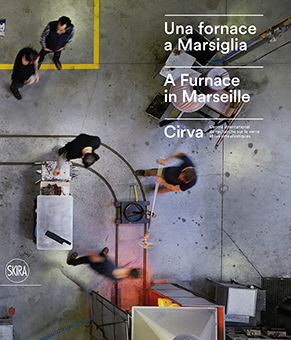
“A Furnace in Marseille. Cirva – Centre international de recherche sur le verre et les arts plastiques” exhibition catalogue, edited by Isabelle Reiher and Chiara Bertola. With an introductory essay by Norman Rosenthal.
Designed as a research laboratory, the Cirva – Centre international de recherche sur le verre et les artes plastiques was established in Marseille in 1986 as a non-for-profit state entity to host international artists, designers and architects wishing to introduce glass to their creative process. These artists, who are often confronted with a difficult to master material for the first time, develop their designs assisted by the Cirva technical team.
Over thirty years, Cirva has hosted around 200 artists for various projects in the fields of contemporary art, design and decorative arts. It also owns a collection of 700 works exhibited in museums and art centers all over the world.
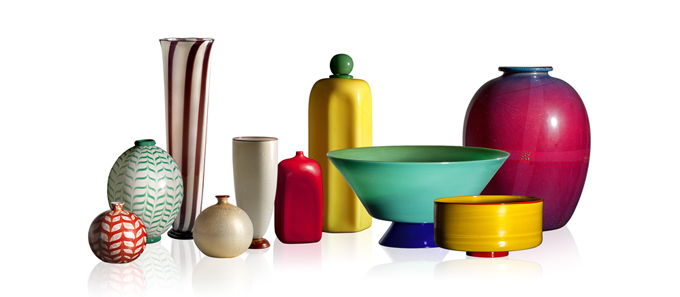
Ahead of the exhibition entitled The Cappellin Glassworks and the Young Carlo Scarpa, due to open in the autumn, the Glass Study Center has organised an international conference on the closely related theme of the Cappellin glassworks. Although the Venini glassworks (the subject of the previous exhibition in Le Stanze del Vetro) will not feature prominently in the conference, nonetheless, in terms of the two exhibitions, the company can be seen as the predecessor to the Maestri Vetrai Muranesi Cappellin & C., the furnace that Giacomo Cappellin founded after ending his partnership with Paolo Venini in the company VSM Cappellin Venini & C.
The one-day conference will focus on the entire production of the Cappellin glassworks (active from 1925 to 1931), highlighting in particular Carlo Scarpa’s artistic contribution.
The topics addressed will include: Scarpa’s work as an architect and designer of glass in the 1920s and his relationship with artisans; Cappellin’s production and exhibitions in Paris and the United States; the relationships established by the company with Turin artists; and an in-depth study of his unique production of stained-glass windows.
DOWNLOAD THE PROGRAMME

A Murano artist and painter interested in the decorative arts, and particularly in glass, Vittorio Zecchin (1878–1947), from 1921 to 1925 and in accordance with a practice not seen in Murano before, occupied the position of artistic director of the V.S.M. Cappellin Venini & C. glassworks, founded in 1921 by the Venetian antiquarian Giacomo Cappellin and the young Milanese lawyer Paolo Venini, together with other shareholders, with the intention of offering a sophisticated, modern style of production. Responding to the demands expressed by Cappellin and Venini, Zecchin designed monochrome blown-glass pieces with extraordinary colours and classical essential lines. Products of this kind, clearly different to anything being offered by their contemporaries and in perfect harmony with the changed public taste, marked a decisive turning point in the 20th-century panorama of Murano and contributed significantly to the renaissance of the sector. The elegance of the design combined with evocative shades of colour also characterised the glass pieces designed by Zecchin (between 1925 and 1926) for M.V.M. Cappellin & C., where he continued working as artistic director after the association between Giacomo Cappellin and Paolo Venini came to an end in 1925. This volume reconstructs for the first time the entire collection of transparent blown-glass pieces designed by Vittorio Zecchin, first for Cappellin and Venini and then for Cappellin alone. It consists of a sequence of about 900 models (from vases to compote bowls, from table services to chandeliers) which were identified following rigorous research. The work of Zecchin is illustrated both by an extensive set of photographs produced for this occasion and a selection of period photographs and drawings, mostly unpublished, coming from the Archivio Storico Venini, Murano, the Archivio del Centro Studi Vetro, Fondazione Giorgio Cini, Venice, and the Archivio Zecchin Ramani, Trieste.
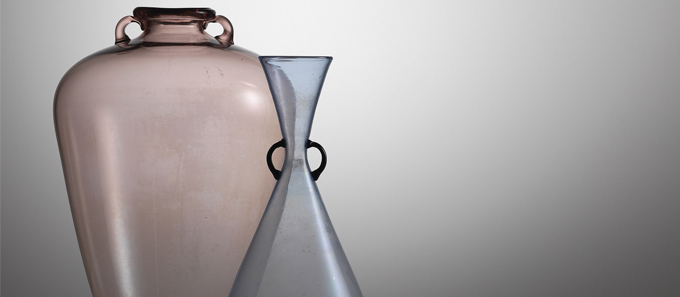
The exhibition “Vittorio Zecchin: Transparent Glass for Cappellin and Venini”, curated by Marino Barovier, will focus on the transparent glass works designed by the artist during the 1920s for the V.S.M. Cappellin Venini & C. company and later for the M.V.M. Cappellin & C.
Born in Murano, Zecchin (1878-1947) studied at the Accademia di Belle Arti in Venice and was especially interested in the artistic trends of the time, in particular in the central European avant-garde movements. He was an important figure in the artistic circle centered around Ca’ Pesaro and the exhibitions organized there: he developed an interest in applied arts, ranging from embroidery to tapestry and especially glass, which became a passion of his.
The glass production designed by Zecchin gained momentum starting in 1921, when he became artistic director of the V.S.M. Cappellin Venini & C. glassware company, founded by Giacomo Cappellin and Paolo Venini, soon to become a reference point both in Italy and internationally.
Generally speaking, the Cappellin-Venini production differred from the Murano glass production of the time, which was characterized by extreme virtuosity. The Cappellin-Venini glass works featured classical proportions together with extremely essential shapes.
The closing of the Cappellin Venini company in 1925 did not put an end to Zecchin’s glass production. He continued to design new items until 1926 for the new M.V.M. Cappellin & C. company, which Giacomo Cappellin established after he parted with Paolo Venini.
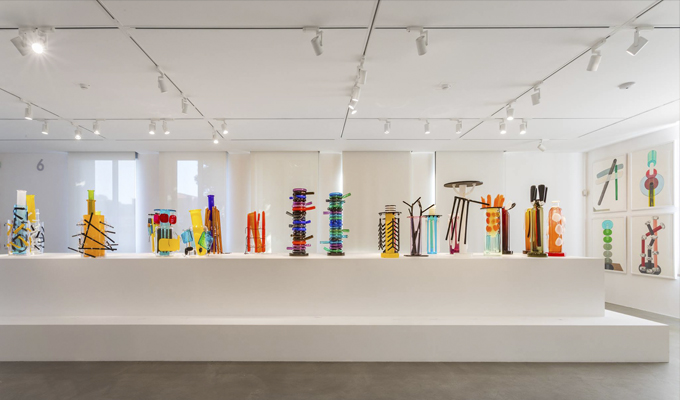
The exhibition Ettore Sottsass: The Glass, curated by Luca Massimo Barbero, Director of the Institute of Art History, sets out to explore the Italian designer’s complete glass production. From the 1940s onwards, Sottsass showed an interest in glass, and at the 1948 Biennale he exhibited some objects made in collaboration with the company S.A.L.I.R. from Murano. In the 1970s, again in Venice, he collaborated with the Cenedese glassworks in designing glass objects in forms that were very similar to those of his ceramics. But it was only after the Memphis group was founded (1981) that he designed thorough-going glass sculptures made by master craftsmen in the Toso glassworks. It was also then that Sottsass introduced the use of chemical glue, thus challenging centuries-old Murano glassmaking techniques.
Consisting of around 200 items, the exhibition will consist of loans from major private collections as well as objects preserved in the historical archives of the Venetian glassworks that Sottsass worked in. Moreover,
the exhibition itinerary also includes some of the splendid glass items he designed for Venini. The exhibition catalogue (Skira editore) has a fairly strictly biographical introduction followed by wider-ranging essays by the curator and the architects, museum directors and scholars who collaborated with him. A complete list of Sottsass’s production, with technical entries for each single item, is also provided, whereas the bibliography,
focused only on the glass production, consists of over 200 titles, and is the result of meticulous archive search.
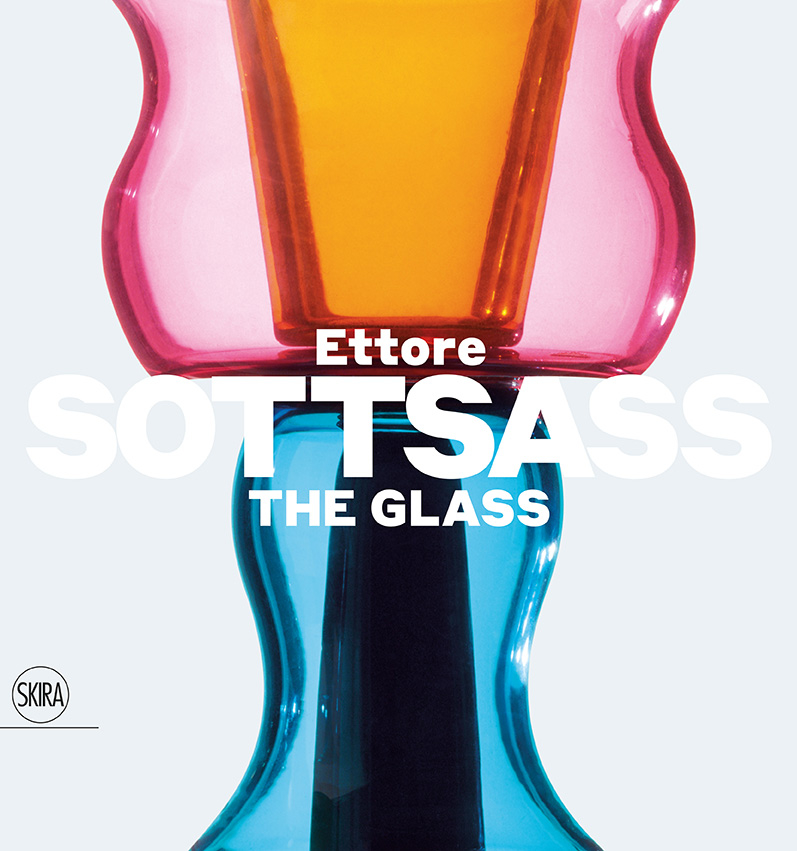
“I’ve tried to get away from the everyday object and sought to make Glass works with a capital G. Of course, that’s a dangerous approach, because I don’t want to be an artist, or a sculptor, but in the end the objects I produce look like glass sculptures, and yet they aren’t: they’re a mix that’s hard to fathom.” The brilliant architect and designer Ettore Sottsass “made glass” from 1947 until the end of his career. This volume documents the entire period of his glass oeuvre, from the series he designed in the 1970s for Vistosi to the Memphis collections of the 1980s, the symbolic forms of the 1990s, the stunning constructions for the Millennium House in Qatar, and the famous Kachinas. The wealth of images, the analysis of design and painting together with the coeval cultural and artistic context, and the summary of works including many unpublished pieces make this volume edited by Luca Massimo Barbero the first scientific study on Ettore Sottsass’s works in glass and crystal. Ettore Sottsass jr (1917-2007) was born in Innsbruck and spent his childhood in the Trentino Region (Northen Italy). He trained in Turin during the 1930s, following the footsteps of his father, architect Ettore Sottsass senior (1892-1954). In 1939 he graduated at the Politecnico in Turin, while at the same time cultivating his passion for painting under the guidance of painter Luigi Spazzapan. In 1946, he moved to Milan where he devoted himself to architecture and collaborated with the Triennale, overseeing the set-up of the handcrafts sections. Sottsass continued to work both as an architect and designer, winning many rewards such as the ‘Compasso d’Oro’, which he received in 1959 for the Elea 9003 processor and Valentine, the first portable typewriter, both produced by Olivetti. He loved traveling: he visited Europe, America and Asia. His travels inspired him and were at the center of many of his conceptual photos. In 1976 the Venice Biennale dedicated a broad retrospective exhibition to Sottsass, curated by Vittorio Gregotti. During the later years of his life Sottsass devoted himself to the organization of exhibitions and collaborated with both industrial designers and well-known galleries.
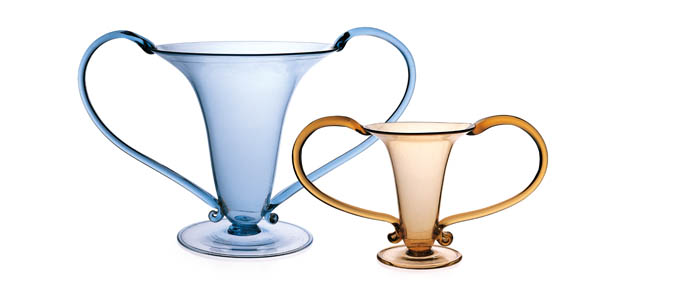
In 2017 the Glass Study Centre continues its series of conferences on designers who have collaborated with the Venini glassworks. The sixth international conference – in the format of a study day associated with the upcoming autumn exhibition – will focus on the Murano artist Vittorio Zecchin (1878-1947).
After graduating from Venice fine art school, Zecchin soon stood out for his impatience with the late 19th-century verista culture and, on the contrary, his interest in some of the new ideas stemming from the Venice Biennale, which led him to pursue research into Symbolism and the works of the Middle-European avant-gardes. Having taken part in the intense season of exhibitions with Ca’ Pesaro as a driving force in Venice (at this time he made and showed tapestries, embroidery and enamelled glass), Zecchin came into contact and collaborated with various people active in the city, such as the painter Teodoro Wolf Ferrari and the glassmakers Artisti Barovier. In his prominent role as artistic director of Cappellin Venini (1921-1925) and then M.V.M. Cappellin & C. (from 1926), he designed glass with an innovative impact and original refinements without ever neglecting research into the stylisation of form.
The papers at the conference will focus on a variety of topics dealing with Zecchin’s experience and inventive skills, while also exploring the associated themes and fields in which he was active. Starting from the Venetian background, the following subjects will be addressed: his personal approach to the decorative arts (including a comparison with the Italian and international scene), the close relationship between painting, glass and the world of the applied arts in general, and his presence at the major events of the time, such as the Biennial Exhibitions at Monza from 1923 to 1927.
DOWNLOAD THE PROGRAMME

Edited by Rainald Franz Curator, MAK Glass and Ceramics Collection, Vienna With texts by Rainald Franz, Pasquale Gagliardi, Valerio Terraroli, Christoph Thun-Hohenstein and Andreas Vass
The Glass of the Architects. Vienna 1900-1937 is the second exhibition dedicated to international developments in 20th-century glass, after Glass from Finland in the Bischofberger Collection. The exhibitions are part of the “Le Stanze del Vetro” project jointly run by the Fondazione Giorgio Cini and Pentagram Stiftung for the purpose of studying and promoting the art of glassmaking in the 20th and 21st centuries.
Published in collaboration with the MAK Vienna and “Le Stanze del Vetro” on the occasion of the exhibition in Venice, the volume presents over 300 works from the collection of the MAK Austrian Museum of Applied Arts / Contemporary Art in Vienna and private collections. It focuses for the first time on the history of glassmaking in Austria from 1900 to 1937, a period spanning the last decades of the Austro-Hungarian Empire and the First Republic.
In the early 20th century a group of young architects, designers, and fine arts and architecture students developed a special interest in the process of glassmaking. Many of them were to become leading figures in Viennese Modernism, such as Josef Hoffmann (1870-1956), Koloman Moser (1868-1918), Joseph Maria Olbrich (1867-1908), Leopold Bauer (1872-1938), Otto Prutscher (1880-1949), Oskar Strnad (1879-1935), Oswald Haerdtl (1899-1959) and Adolf Loos (1870-1933). They paved the way to the first pioneering developments in 20th-century glass production as they worked with the furnaces in order to gain a thorough understanding of the material. The collaboration between architects and designers, and the introduction of their innovations to production, created the style of Viennese Glass found in new projects such as the Wiener Werkstätte or the Austrian Werkbund.

A protagonist of Murano glass in the 20th century, Paolo Venini (1895–1959) with his passionate activity spanning almost forty years, made a decisive contribution to the vitality of the art of glass, achieving extraordinary results soon recognised also internationally. A native of Milan and a former partner in the Cappellin Venini firm, in 1925 he founded the V.S.M. Venini & C. glassworks with Napoleone Martinuzzi and Francesco Zecchin as partners, from whom he separated in 1932. Becoming president of the company, he worked untiringly as the undisputed director and manager of the Venini firm up to his death, which occurred in 1959. In defining the catalogue of the glassworks, he also contributed as the inventor of new series of glass pieces in the mid-1930s, but in particular during the 1950s.
This volume, the fruit of in-depth research based mainly on the unpublished material coming from the Venini Historical Archive, illustrates principally this aspect of his activity through a succession of some three hundred models. For the greater part of these Paolo Venini had recourse to the traditional Murano techniques, of which he gave a refined and innovative interpretation, resulting in the Zanfirico reticello, Mosaico zanfirico and Mosaico multicolore series and the highly coloured a murrine glass pieces. The influence of Nordic design was also significant, being reinterpreted through Murano eyes. The volume also documents the contribution of the artists who worked with him intermittently between the 1930s and the 1950s, called upon by Venini himself or arriving independently because of their interest in glass and/or the quality of the work at the furnace. Two hundred and fifty glass pieces tell the story of the collaboration of the Swedish ceramic artist Tyra Lundgren, of Gio Ponti, Piero Fornasetti, the painters Eugène Berman and Riccardo Licata, but also the Americans Ken Scott and Charles Lin Tissot. To them must be added the architects, Massimo Vignelli and Tobia Scarpa, and the Norwegian designer, Grete Korsmo.
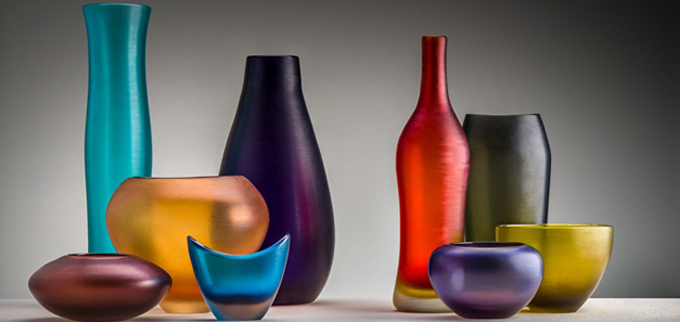
Checkered ‘murrine’ glass vases and bowl, 1953
Curated by Marino Barovier for Le Stanze del Vetro, the exhibition Paolo Venini and His Furnace is devoted to a pioneering figure of 20th-century glass, whose passionate work made a crucial contribution to the liveliness of the art form. Previously a partner in Cappellin Venini and originally from Milan, Paolo Venini (1895–1959) founded the V.S.M. Venini & C glassworks in 1925 with the assistance of Napoleone Martinuzzi and Francesco Zecchin; the latter then left in 1932. Having become company president, Venini worked tirelessly as a great orchestrator and manager of the furnace until his death in 1959. A cultivated entrepreneur who took a keen interest in contemporary artistic developments as well as the demands of the international markets, Venini also personally designed a new series of glass objects, with the aid of his design office, and contributed to the extensive glass catalogue which in the meantime had also been enhanced by contributions from several artists. Thanks to careful research work, the exhibition and catalogue document the production determined by Paolo Venini’s specific decisions, which led, for example, to the series called Diamante in the second half of the 1930s. But it was in the 1950s that Venini regularly worked on creating his own glass designs, which enjoyed considerable success at the Milan Triennial and the Venice Biennale as well as at various international events in Europe and the United States, held to promote Italian craftsmanship and design. The many glass objects designed from 1950 to 1954 reveal a refined reinterpretation in an innovative key of some traditional Murano techniques, such as zanfirico. Although mainly focusing on the remarkable personality and role played by Paolo Venini, the exhibition also illustrates the production resulting from sporadic collaborations from the 1930s to the 1950s with artists and designers, such as Tyra Lundgren, Gio Ponti, Piero Fornasetti, Eugene Berman, Ken Scott, Charles Lin Tissot, Riccardo Licata, Massimo Vignelli, Tobia Scarpa and Grete Prytz.









